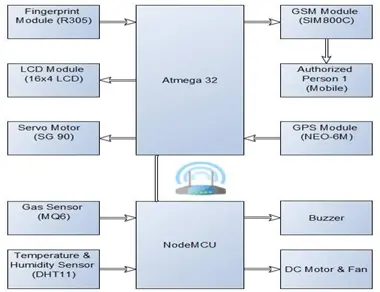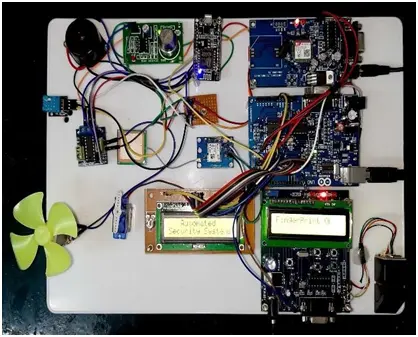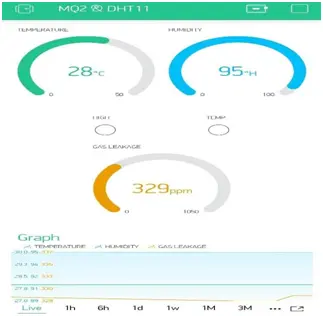1. INTRODUCTION
Advancements in security systems have notably progressed, incorporating smartphone control and the utilization of microcontrollers and Graphics Processing Unit (GPU) based microprocessors within a brief timeframe. These enhancements in technology have facilitated automation systems, offering convenient features that streamline daily life. Enabling remote control of appliances via smartphones, whether in a home or office setting, has been made possible through efficient wireless communication. Instances of accidents caused by gas leaks or fires in factories and homes have been reported at an alarming rate. During such emergencies, individuals often find themselves helpless, awaiting emergency services for rescue. These situations can involve various objects, ranging from household appliances to vehicles, necessitating anti-theft measures.
In the realm of IoT, geographical distance holds minimal significance, serving as a driving force behind its application. The primary objective of incorporating this technology in the project is to design an IoT Smart Home, featuring four applications that provide real-time updates to the homeowner via a smartphone. This project aims to address the deficiencies observed in traditional security systems by delivering timely information about the status of the household or workplace when the owner is absent. Additionally, it emphasizes bolstering IoT network security through robust encryption and decryption protocols to safeguard user data.
This paper is structured into smaller sections organized as follows:
– Section II delves into the prior work conducted in both Automation and Security Systems, as documented by various papers in previous years.
– Section III elucidates the schematic block diagram and outlines the procedural framework employed throughout the paper.
– Section IV details the implemented system, providing comprehensive insights into the functionality of the utilized components.
– Section V delineates the operational flow within the system and proposes potential modifications to enhance the efficiency of automation and security systems.
– Section VI concludes the paper by discussing the future scope and potential implementations derived from the ideas presented within the paper.
2. LITERATURE SURVEY
In 2018, Ashwini Pawar and V M Umale utilized Raspberry Pi to monitor indoor and outdoor surroundings, requiring internet connectivity [1]. Their focus was on establishing IoT-based home security, necessitating a platform for connectivity and programming, leading them to opt for the latest Raspberry Pi model. The primary objective of their work was to enhance home security, aiming to prevent damage and theft incidents.
In 2015, Balakrishna Gokaraju emphasized the cost and time-efficient wireless communication of intrusion events to homeowners and law enforcement, complete with confirmed images of the scene during the event [2]. This study aimed to compare design and program implementation between ARM microprocessors and ATMEGA microcontrollers.
In 2012, Mansour H. Assaf explored the limitations of conventional security systems, primarily focusing on increasing thefts and the failure to collect accurate theft-related data using technology like FPGA [3].
In 2017, Mile Mrinal implemented a security system utilizing Android mobile devices and Bluetooth as a wireless connection protocol [4]. This system facilitated remote operation of doors, temperature, humidity, and light switches using a smartphone.
In 2016, Mallesham Yerragolla proposed an Intelligent Security System for Residential and Industrial Automation [5]. This system incorporated remote control techniques and wireless applications for home and industry applications, encompassing environment detection, diagnosis, appliance control, and robotic modules. The system utilized multiple sensors and could detect unknown persons, capturing photos and notifying the owner.
In the same year, Ravi Kishore Kodali presented a wireless system sending alerts to the owner via the internet [6].
In 2017, Prathibha S R focused on IoT sensors for efficient farming, monitoring temperature, humidity, and capturing images sent to farmers’ mobiles through Wi-Fi [7].
Shradha Somani reviewed a security system in 2018, utilizing the internet to send intrusion notifications and activate alarms [8]. Home automation and appropriate sensors were employed to achieve this security setup.
Dhairya Agarwal, Souvik Roy, Sandhya Elizabeth Anto, Sundar S, and Vidhyapathi C M implemented Raspberry Pi-based sensors for controlling electrical appliances and ensuring user authentication and security.
In 2018, Tridha Chaudhuri explored a security system emphasizing home monitoring and automated control of appliances with human intervention [9].
Vishakha D. Vaidya and Pinki Vishwakarma, in 2018, examined a Smart Home System, comparing technologies like GSM, Bluetooth, IoT, PIC Microcontroller with ZigBee modulation, and automation for remote control of light, fan speed, and other home appliances [10].
3. PROPOSED SYSTEM MODEL
The systematic representation of the model with proper explanation is explained below:

In Figure-1, the system captures fingerprint input and verifies if it belongs to a registered user. Upon successful verification, access is granted, which is displayed on the LCD screen. Subsequently, a signal is sent to the NodeMCU microcontroller, enabling the automated door to open. Once the door is open, real-time detection of gas leakage, temperature, and humidity occurs using the MQ6 gas sensor and DHT11 sensor. This data is then transmitted to the Blynk application depicted in Figure-4. Users can access and monitor this real-time information. If the temperature exceeds 50°C, the DC Motor initiates rotation, activating the buzzer for emergency alert, and simultaneously notifying emergency services.
4. SYSTEM DESIGN
Description of Atmega32
The ATMEGA32 is an 8-bit microcontroller featuring a total of 28 pins, with 23 of these functioning as programmable I/O lines, offering both read and write capabilities. Operating within a voltage range of +1.8 to +5.5 volts (with +5.5 volts being the absolute maximum), the ATMEGA32 can operate at a maximum clock speed of 20 MHz.
Description of NodeMCU (ESP8266)
The NodeMCU consolidates various components within a computer or electronic systems. This open-source platform allows for the modification, editing, and building of its hardware design. It incorporates the ESP8266 WiFi-enabled chip, known for its cost-effectiveness, enabling toggling at clock speeds ranging from 80 to 160MHz.
Description of GSM Module (SIM800C)
The SIM800c operates as a Quad-band GSM/GPRS solution, providing performance across the 850/900/1800/1900 MHz frequencies and is adaptable for customer applications. It features a highly robust single-chip processor in its design.
Description of GPS Module (NEO6M)
The NEO-6M represents a widely favored GPS module, known for its cost-effectiveness and high performance. It comes equipped with a ceramic patch antenna, a memory chip, and a backup battery, facilitating seamless connectivity with a range of microcontrollers. This module utilizes a UART interface set at a baud rate of 9600, enabling efficient serial communication.
Description of Fingerprint Module (R305)
The R305 serves as a fingerprint sensor module featuring a TTL UART interface. It possesses the capability to store and compare fingerprints as per the user’s preferences. Users can configure it in either 1:1 or 1:N mode for person identification purposes. This module can be easily interfaced with a 3.3V or 5V microcontroller and operates at a default baud rate of 57600.
Description of Temperature & Humidity Sensor (DHT11)
The DHT11 utilizes its own 8-bit microcontroller to transmit temperature and humidity values serially. It effectively measures temperatures up to 50°C and humidity levels up to 90%, providing accurate readings with a precision of ±1°C for temperature and ±1% for humidity.
DESCRIPTION OF GAS SENSOR (MQ6)
This module serves to identify hazardous and toxic gas leaks. The MQ-6 has the capability to detect gas concentrations ranging between 200 and 10,000 parts per million (ppm).
Description of Servo Motor (SG90)
This particular module is a 180° rotation servo that identifies PWM signals while functioning at +5V. Users have the ability to set the rotation angle as per their specific requirements.
Description of LCD Display (16×2)
The Liquid Crystal Display (LCD) is an electronic module utilizing liquid crystal to generate visual images. This specific LCD module comprises 16 columns and 2 rows, totaling 32 characters, with each character formed by 5×7 pixel dots.
5. RESULTS AND DISCUSSIONS
The Atmega32 and NodeMCU are connected with various electronic components, sensors and LCDs as shown in Figure-2.

The R305 Fingerprint Module captures the user’s fingerprint and cross-references it with the stored fingerprint database. Upon a successful match, this information is relayed to the Atmega32, which in turn triggers the door to open. The Atmega32 also employs the Neo-6m GPS Module to determine the latitude and longitude. This location data is then transmitted to the owner’s mobile device using the SIM800C GSM Module. The message received by the owner contains pertinent information and the individual’s location pinpointed on Google Maps, revealing the location of attempted access, whether it’s a home, office, industrial area, factory, or vehicle, as depicted in Figure-3.

The DHT11 Temperature and Humidity Sensor, along with the MQ 6 Gas Sensor linked to the NodeMCU, consistently monitor the environmental changes. The NodeMCU transmits this gathered data to Blynk. Figure-4 displays a comprehensive view presenting real-time values and graphs depicting temperature, humidity, and gas leakage fluctuations.

When the ambient temperature surpasses 50C, both the buzzer initiates ringing and the DC Motor begins rotating.
Table 1 Comparative studies of the proposed model with previous models.
| S. No. | Existing Model | Proposed Model |
| 1. | Ashwini Pawar (2018) uses Raspberry Pi in their model which makes it less economical [1]. | In our project with the application of NodeMCU and Atmega32 we have made our project cost effective and efficient to some extent. |
| 2. | Balakrishna Gokaraju (2015) utilizes Wi-Fi for intruder detection and email is sent afterwards by the help of ARM microprocessor [2]. | In our project with the usage of GSM & GPS System and by the help of Atmega32 microcontroller sends the information which can be accessed anywhere in the world through message and location in case of automobiles. |
|
3. | Mansour H. Assaf (2012) aims on the development of a home security and monitoring system where user can use the system through a web page using internet [3]. | In our project instead of using web-based interface we have used Blynk app which measures gas, humidity and temperature inside the house which has easy interface. The servomotor is used in this case with the help of fingerprint module to open the door which does not require remote control system. |
|
4. | Mile Mrinal (2017) describes the use of a security system that uses mobile devices and its features as a wireless connection protocol [4]. | In our project, the implementation of GSM and GPS overcomes the limitation of Bluetooth which is distance covered. |
|
5. | Mallesham Yerragolla (2016) presents wireless applications using remote systems [5]. This project was also tested using different instances. In the case of unknown persons, proofs were taken and were sent to the owner. | In our project with the help of sensors and wireless communication covered an at least 1-5 km which can’t be covered by remote control instruments. This project can be implemented in automobiles where the intruder’s location is shown in google maps which is easy to access and camera is not required making it cost effective. |
|
6. | Ravi Kishore Kodali (2016) builds a smart wireless home security system using Internet. The alerts and the status are sent by the Wi-Fi connected microcontroller managed system [6]. | In our project with the help of fingerprint scanner and Global Positioning System and Global System (GPS) for Mobile (GSM) it eliminates the use of internet. It is especially useful in some areas where there is slow connection of internet for tracking location as only google maps is the only application which needs to be opened in case of vehicles. |
| S. No. | Existing Model | Proposed Model |
|
7. | Prathibha S R (2017) focuses on the evolving technology i.e. IoT and smart agriculture using automation [7]. | In our project with the help of dc fan and motor, we can reduce the temperature and humidity which helps to keep the crops alive for sometimes. The detection of higher temperature by the Blynk app will alert farmers and can give water accordingly. |
| 8. | Shradha Somani (2018) makes a wireless home security system using the concepts of Internet of Things. The sensor here used is Raspberry pi [8]. | In our project the user is allowed to do login with fingerprint scanning and usage of Atmega32 microcontroller and NodeMCU can reduce the cost taken by Raspberry pi to some extent. |
|
9. | Tridha Chaudhuri (2018) presents a security system by which one can monitor and control one’s home and implements an automated way of controlling home appliances by the help of human interaction and be able to monitor their home devices using their smartphones when connected to the same local area network [9]. |
In our project IoT concept can be used to connect different sources of information such as sensors, mobile phones, home and appliances in a firm. It could use a user Interface to make the system more interesting and does not require local area network as internet is a better option. |
|
10. | Vishakha D. Vaidya (2018) deals with a comparative study of smart home system based on technologies which generally uses wireless communication with limited range [10]. | In our project, GSM and GPS usage minimizes the limitation of Bluetooth, ZigBee. This project evaluates the comparison done in that project and implemented it accordingly to make it useful and cost effective. |
6. CONCLUSION AND FUTURE SCOPE
This automated security system stands as a dependable and effective solution, allowing prompt corrective measures. Its continuous wireless monitoring capability significantly reduces human intervention, offering an economical and power-efficient operation. This synthesized security system has been specifically designed to enhance efficiency and is adaptable to various automated systems, be it household security, automotive, or industrial applications.
Providing real-time data on temperature, humidity, and gas leakage in the vicinity, the system promptly notifies users of any deviations from optimal ranges. Implementing such a system has the potential to significantly advance security measures and overall global productivity.
Future enhancements for this system could involve integrating modern techniques, such as incorporating a camera module using Raspberry Pi for enhanced surveillance, integrating touch display units for improved user interfaces, and exploring the use of solar power sources to optimize energy efficiency.
